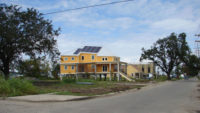A year ago, actor Brad Pitt presented lot owners in the devastated Lower 9th Ward of New Orleans with a portfolio of designs by 13 well-regarded architects, saying, in essence, choose a design and your house will be built.

The first six homes built by Pitt’s Make It Right Foundation are now finished. They represent not only fresh starts for homeowners, but also blueprints for affordable, storm-resistant, and sustainable housing designs. “The goal is to bring people back,” says John Williams, the New Orleans architect supervising the endeavor. “But this project is also a laboratory for what can be done here and elsewhere.”
Heavily subsidized by Pitt’s foundation, the per-house budget of $150,000 is possible because of donated materials and services, including the architects’ designs. Williams acknowledges that these prototypes exceeded the budget, but says costs will drop as more houses are built. The goal is to build 150 homes; Pitt’s foundation has raised money for 87 of them.
The first homeowners selected designs by Billes Architecture and Concordia, both New Orleans firms, along with KieranTimberlake of Philadelphia and Los Angeles-based Graft. With their edgy silhouettes and exuberant color schemes, the new houses stand in stark contrast to the ruined neighborhood that surrounds them.
In late August, as work neared completion, the first houses were tested by Hurricane Gustav’s 115 mph winds. Not even a window was lost, due, no doubt, to impact-resistant glass or removable hurricane fabric systems for all doors and windows. Built to accommodate a high-water event, the houses were raised at least five feet, with foundations resting on piles driven 35 feet into clay-like soil. But rooftop escape hatches address worst-case scenarios.
The houses are among the first in the city to earn LEED Platinum certification. Some materials used, such as sustainable wood cabinetry, non-toxic paints, and Energy Star appliances, are in broad use these days. Green features that take these houses to the next level include insulation that makes them five times more air-tight than typical homes, photovoltaic systems, and groundwater heat pumps for both heating and cooling. In a forward-thinking conservation measure, separate plumbing lines were installed so owners can utilize their rain harvest systems if a current state law banning rainwater for toilet use is repealed.
While homeowners were given the option of altering plans, homes were built largely as designed. Richard Kravet, a partner at Billes Architecture, says one client asked that the house be raised from five to eight feet. The additional height created an open-air basement level. To add some privacy to that space and keep the house from looking as though it is wearing stilts, one exterior wall was extended to the ground. “But in the event of a flood,” Kravet explains, “this wall extension would break away so flood pressure would not compromise the house.”
The only two-story dwelling to be built so far was designed by Concordia. Steven Bingler, its principal, says his design objective was to marry the local front porch culture with 21st century design and building techniques. To that end, Bingler gave the houses wide steps and generous front and side porches. The pitched roof is both a nod to the regional architectural tradition and an optimum position for the solar panels.
The flat-roofed house designed by James Timberlake, of KieranTimberlake, is the most overtly contemporary in the first group. In time, its sharp angles will be softened with a south-facing, vine-filled screen shading the porch and house. The metal cutouts that front the porch and its banister lend a whimsical, arty touch to the design.
So far all of the houses are stick-built with the exception of two designed by Nora Gordon of Los-Angeles based Graft. Prefabricated in North Carolina, the raised modular home’s shallow pitched roof gives it a cottage-like look that is offset by its asymmetrical staircase.
Work is already under way on additional homes; in fact, Williams expects to have 40 completed by this summer. For the next phase of development, lot owners have selected designs by Billes and Graft, along with those by Shigeru Ban Architects; BNIM Architects of Kansas City; Eskew+Dumez+Ripple of New Orleans; and Constructs of Accra, Ghana.
To view schemes by all 13 architects, check out our December 2007 story “Pitt Unveils Sustainable Designs for New Orleans.”



Post a comment to this article
Report Abusive Comment